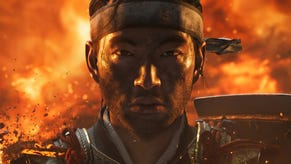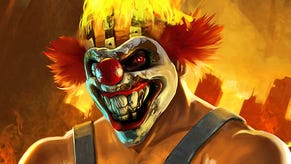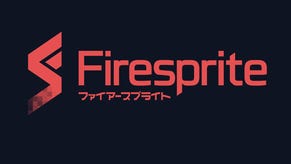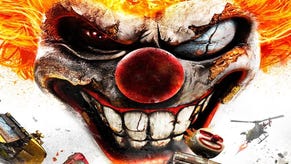Twisted Metal
Mettle detector.
"There is a wholesale abandonment of track-based racing," says Jaffe, considering why they failed. "Unless you're dealing with real hardcore reality racing simulations, people just seem to be going, you know, 'I can get that and more in these games that are amalgams of a number of genres.'
"Every genre is getting assimilated into experience versus genre [so] that the idea of genre-specific games – this is a fighter, this is a racer, this is a shooter – I really think, in the next generation beyond this one, it will continue to become what we'll one day consider relics of the past."
Whatever Twisted Metal is, it's a blast. I try out three modes of increasing complexity: free-for-all Death Match in a suburban setting; Team Death Match in a dynamically changing arena of destruction; and, lastly, Nuke, Twisted Metal's take on capture the flag.
The first offers a suitably freeform, riotous opportunity to get to grips with the various vehicle types and their firepower. Additionally, it highlights the improved environmental destruction – something the game was slapped for at E3 and Eat Sleep Play has worked hard on to improve. After all, why go around the house when you can go through it?
It takes a fair few hits before a player is destroyed, so risk-taking and experimentation are encouraged. There's sufficient warning that your health is low, but if an opponent spies your empty health bar, you'll be under severe pressure to make it to a health pickup in time.
Black Rock Arena is up next, a dazzling homage to Twisted Metal 2's Suicide Slides. Around the large, open battle space in the middle of the arena there are wide, high ramps, lava pits, electrified routes, spikes stabbing up from the ground and giant wrecking balls swinging in the sky.
The arena itself dynamically alters, walls rising and falling, changing the space from, as Jaffe puts it, "open battlefield to rats in a maze", forcing you to adapt on the fly.
The scope for strategic teamplay is obvious. Take, as an example, the health orb flying around the arena. If you drive under its beam it recharges health, but its reserves are limited.

So do you use it as soon as you need it then destroy it to prevent the opposition from benefiting? Or, if an ailing ally in a slow vehicle is far away and you're in the chopper (the series' first aircraft), do you magnet-whisk them away from danger and towards a health boost?
Meanwhile, the Juggernaut, new to the series, offers sanctuary to the severely damaged, with team-mates able to nip up a ramp and into its trailer, providing temporary safety and mounted guns to play with.
Life conservation is especially important in the mode I play, Team Death Match with shared lives, where everyone draws from the same pool. Once they and you are gone, you're confined to the role of spectator.
There are strategic decisions to be made right across the map. The lava won't kill you but will drain energy, so can you make it through using your shield to grab that pickup?
Finally, it's time for Nuke, a hardcore multiplayer mode Jaffe calls the game's "deep end of the pool". He's not kidding. It's team-based capture the flag which, having evolved since its E3 showing, is now divided into baseball-like innings, with teams alternating between offense and defence. "We're so proud of this, it's so much design work," Jaffe tells the assembled press.
The idea in offense is to capture a faction leader, drag them to a missile launcher, wait a pre-determined time in the 'sacrifice zone', then launch a missile that must then be steered into an opponent's statue, earning you a point. Phew.
It's easy to see how well-organised teams will prosper. Time required in the sacrifice zone varies by vehicle. The helicopter is super-slow, but can carry a fast-sacrificer to the zone. The Juggernaut's container offers even greater protection when flanked by a convoy of tough SUVs. But even this defence can be breached by Specter's secondary Special – a 360-degree EMP attack – which takes out everyone's engines, leaving them wide-open to attack.

And so on. The demonstration videos Jaffe shows do a much better job of illustrating the potential than my own cack-handed, still-confused efforts. It seems likely that only the truly dedicated Twister Metal players will reach these mesmerising heights of co-operative endeavor, and its creator acknowledges the challenge this implies.
"I'm so hopeful that at least a large enough group of gamers play this mode and really get into to the tactics and figure it out," he says. And if Twisted Metal is more shooter than racer, its October release date will put it right in the firing line of online attention-hoggers Battlefield 3, Resistance 3 and, presumably, Modern Warfare 3.
"I'm real proud of it," Jaffe reveals. "Some of the best design we've ever done is in this game, some of the best gameplay we've ever provided. The chips will fall as they will, but there's no value to worrying about that once you've pulled the trigger."
Asking the studio to turn its PSN title into a no-holds-barred full-price experience was a huge vote of confidence by Sony, which, lest we forget, did rather well out of Jaffe on PlayStation 2.
But that means the marketing department, particularly in Europe, must now also vote with its wallet, to give the game the best possible shot in the sink-or-swim end-of-year maelstrom.
As bold, brash and irrepressible as his games, you can count on Jaffe do his bit. Really, you'd be a nob to think otherwise.















